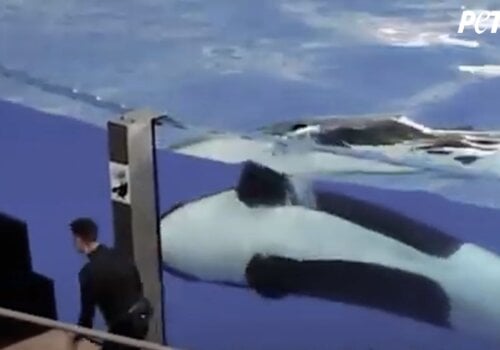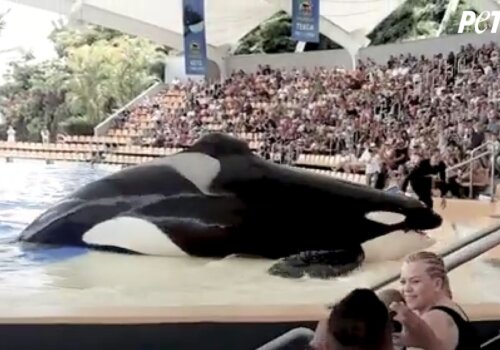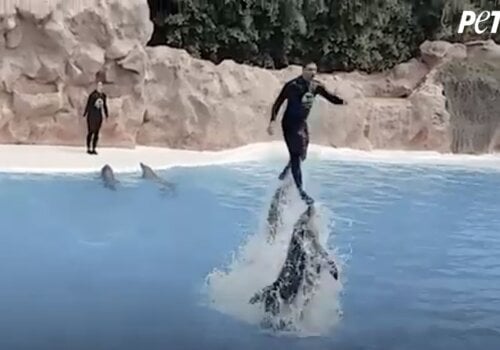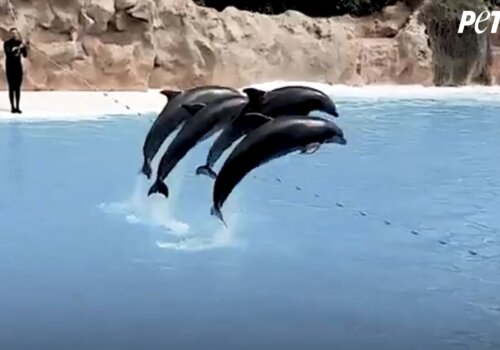Car Park–Sized Concrete Prisons
A group of as many as nine bottlenose dolphins is imprisoned at Loro Parque. They are crammed together, with no escape, into a prison cell smaller than the car park.
Far from soaring through the unending vastness of the sea, they are sentenced to life in a small tank at Loro Parque.
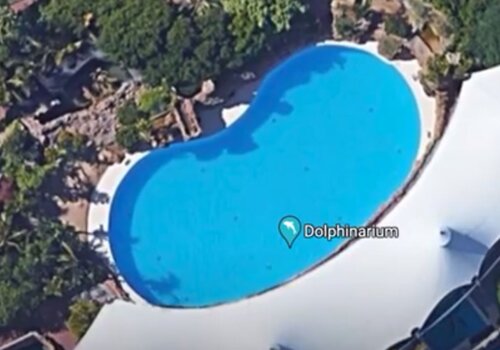

Forced to Perform Demeaning Tricks for Food
Footage filmed at Loro Parque reveals the demeaning circus-like tricks orcas and bottlenose dolphins are forced to perform to amuse the audience, such as swimming in circles, leaping into the air, and sticking out their tongue. Trainers also grab them and stand on their faces, regardless of the discomfort it may cause them.
The dolphin’s lower jaw (or mandible) supports nearly the full force of the trainer’s bodyweight during tricks that involve standing on their faces (or rostrum). The mandible is a sensitive structure that plays an important role in dolphins’ hearing. It’s filled with delicate fatty tissue that allows them to receive underwater sound vibrations through the jaw bone. These are then transmitted directly to the middle ear, where they’re perceived as sound. Routine exposure to excessive or abnormal force on these structures could not only be uncomfortable but even cause damage.
The orcas and bottlenose dolphins at this facility do not get holiday leave or a retirement. They are used as money-making machines, obliged to beg for frozen fish, and confined to a cramped, barren concrete tank until they die.
Loro Parque’s Long History of Orca Death
Morgan has been held at Loro Parque for over 11 years. Her daughter, Ula, died here in 2021, at just 2 years old. Morgan’s captivity continues.
Ula is one of three orcas who died at Loro Parque from 2021 to 2022. In September 2022, Kohana died at just 20 years old – decades short of her natural life expectancy. Skyla was the third orca to pass away within this short period of time, at just 17 years old.
Skyla’s father was Tilikum, the orca whose suffering was exposed to millions in the documentary Blackfish after the frustration of confinement and lack of autonomy led him to kill three people, including trainer Dawn Brancheau, for which SeaWorld appeared to put him through a year of solitary confinement. Skyla’s mother was Kalina, SeaWorld’s original “Baby Shamu” and the first orca born in captivity to survive to adulthood. Skyla was just 2 years old when she was torn away from Kalina and shipped thousands of miles to the Canary Islands, where she languished in captivity at Loro Parque for 15 years without ever knowing freedom or exploring the vast ocean that should have been her home.
Orcas in their natural habitat normally live between 30 and 50 years. Their estimated maximum life expectancy is 60 years for males and 80 years for females. However, in captivity, the average age of orcas is only about 14 years.
Orcas and Bottlenose Dolphins Belong in the Ocean
Whales and dolphins are complex, highly intelligent animals who have their own language and culture.
Like humans, many orcas and bottlenose dolphins in the ocean stay with their families for life and even pull playful pranks. In nature, orcas form complex relationships, work cooperatively to find food, and can traverse up to 140 miles of ocean every day. Bottlenose dolphins can swim up to 60 miles per day.
However, those held captive in marine parks are often separated from their family and held in cells with incompatible groups.
What You Can Do
Animals are not ours to use for entertainment. Never visit Loro Parque or any other facility that profits from keeping animals in captivity.
Please take action to stop the exploitation of whales and dolphins in tourism:

